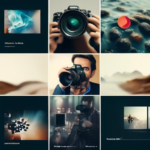In the vast expanse of the digital universe, where pixels become art and imagery speaks louder than words, finding the perfect stock photo can often feel like hunting for a needle in a haystack. It’s an endeavor where creativity meets commerce, and where your vision dances on the edge of elusive perfection. You open your browser, hopeful and determined, yet an endless sea of images soon begins to blur into an overwhelming, oceanic whirlpool. Fear not, weary traveler of the digital realms; you are not alone in this quest. In this article, we will explore the hurdles and headaches of this modern creative pursuit—the elusive capture of that one, ideal stock photo that perfectly encapsulates your story. Join us as we navigate through the trials, tribulations, and, ultimately, the triumphs of turning your conceptual dreams into a vivid visual reality.
Table of Contents
- Navigating the Sea of Stock Photo Options
- Unmasking the Myths: Quality vs. Quantity
- Authenticity in Imagery: A Double-Edged Sword
- The Authenticity Dilemma: Striking a Realistic Chord
- Understanding Licensing: Avoiding Legal Pitfalls
- Balancing Trends and Timeless Appeal
- Tailoring Visuals to Match Your Brand’s Voice
- Cultural Sensitivity: Universality Without Stereotypes
- Maximizing Your Search: Expert Tips and Tools for Success
- In Conclusion
Navigating the Sea of Stock Photo Options
Embarking on the quest for the ideal stock photo can often feel like juggling a myriad of options in a labyrinth of pixels. The sheer abundance of choices, while exhilarating, can be daunting. Here are a few tips to help streamline your search:
- Diverse Platforms: There are countless stock photo websites, each with its unique strengths and pricing models. Familiarizing yourself with the offerings of popular platforms like Unsplash, Shutterstock, and Adobe Stock can save you time.
- Search Filters: Utilize search filters to narrow down results. Filters such as color, orientation, and subject matter can zero in on the most relevant images.
However, even with these tools, uncovering the image that perfectly aligns with your vision is not always straightforward. The process can be marred by:
| Challenge | Solution |
|---|---|
| Overabundance of Choices | Define your needs precisely before searching |
| Generic Images | Seek out niche or lesser-known photographers |
| Licensing Confusion | Read the licensing agreements carefully |
Unexpected delays can arise from issues such as mismatched licenses or an overly generic photo library. Sometimes, an image that looks perfect at first glance may not align with your brand’s aesthetic upon closer inspection. Here, the user reviews and ratings can act as your compass.
Ultimately, consistency is key. Establishing a cohesive visual style and staying patient during the search will pay off in the end. Remember: a well-chosen photo not only complements your content but also enhances your message’s impact.
Unmasking the Myths: Quality vs. Quantity
One of the biggest dilemmas when sourcing stock photos is understanding the delicate balance between quality and quantity. A common misconception is that more images in a library lead to better choices. However, this isn’t always the case. Having a vast collection may seem appealing, but if the quality is subpar, it can drag down the professional appearance of your project.
Think about it: would you prefer to sift through hundreds of mediocre images or a curated selection of extraordinary ones? The latter often wins, saving time and enhancing the overall aesthetic. **Attention to detail** can make or break an image. High-quality visuals with sharp resolution, proper lighting, and relevant content elevate the user’s experience and credibility of your brand.
Here are a few elements to consider when determining the right balance:
- **Relevance**: Ensuring the images align with your message or theme.
- **Resolution**: High-def pictures make a significant difference.
- **Consistency**: Maintaining a uniform look and feel throughout your visuals.
- **Uniqueness**: Stand out by selecting photos that aren’t overly used.
Sometimes, a table might help in summarizing the pros and cons of focusing on either quality or quantity:
| Focus | **Advantages** | **Disadvantages** |
|---|---|---|
| Quality | Enhances brand; Professional look | Fewer options; Higher cost |
| Quantity | More choices; Diverse scenarios | Possible lower quality; Overwhelm |
prioritizing quality over quantity in stock photos can lead to more cohesive, visually appealing projects. While it may come at a higher cost or reduced selection, **the impact of premium images** often outweighs these drawbacks. Strike a balance tailored to your project’s needs, but always remember: an image worth a thousand words should also reflect your brand’s highest standards.
Authenticity in Imagery: A Double-Edged Sword
In an era where visuals speak louder than words, the pursuit of the perfect stock photo can be daunting. To resonate with audiences and maintain credibility, images must not only be high quality but also authentic. Yet, this quest for authenticity in stock imagery presents numerous challenges.
Quality vs. Relatability: Stock photos often walk a fine line between professional quality and genuine relatability. High-resolution images are a dime a dozen, but many lack the authentic touch that connects with audiences. Striking the perfect balance can be a conundrum. Here are a few factors to consider:
- Realism: Modern audiences crave realism. Overly staged or exaggerated scenarios can feel disingenuous.
- Diversity: The need for representation means images must reflect a variety of backgrounds, ages, and lifestyles.
- Context: An image that fits the narrative and context of the content is crucial for coherence.
Furthermore, the availability of truly genuine moments captured on stock photo websites is limited. Many images skew towards generic or overly idealized portrayals, which can alienate rather than attract viewers.
Custom vs. Stock: Another dilemma is whether to invest in custom photography or rely on stock images. Custom photos offer unparalleled authenticity but come at a higher cost and require more time. Stock photos, while affordable and accessible, may lack the uniqueness required for some brands. Below is a comparison:
| Aspect | Custom Photos | Stock Photos |
|---|---|---|
| Cost | High | Low |
| Authenticity | Very High | Variable |
| Uniqueness | Exclusive | Common |
| Time | Extensive | Minimal |
Ethical Concerns: Lastly, the ethical implications of using stock photos cannot be overlooked. Ensuring that images are sourced ethically, with the consent and fair compensation of subjects, is paramount. The misuse or misrepresentation of people in photos can lead to negative publicity and a breach of trust with your audience.
while finding the perfect stock photo is fraught with challenges, understanding these key aspects—quality versus relatability, custom versus stock, and ethical concerns—can guide you towards making more informed, effective decisions.
The Authenticity Dilemma: Striking a Realistic Chord
Finding the perfect stock photo is often like searching for a chameleon in a box of Crayolas; you want vibrant, but you end up with something that feels unnervingly like a painted-on smile. One significant challenge is maintaining **authenticity**—finding an image that resonates truthfully with your message. Often, stock photos can feel overly staged, having a pristine air that seems too good to be true.
- Faces and Expressions: It’s not uncommon to find photos where every face beams with an exaggerated glow, lacking the nuanced expressions of real emotion.
- Settings and Backgrounds: Perfectly arranged desktops, streets with not a speck of dirt, and homes that appear untouched by actual human presence. It makes you question if these places exist in our world or in an alternate, cleaner dimension.
- Props and Attire: The problem extends to props too uniform and attires that seem chosen by a whimsical wardrobe orchestrating perfection.
Another layer to this dilemma arises when focusing on capturing diversity and inclusivity. While stock photo libraries have been making strides, many images still fail to encapsulate the richness and variety of real human experiences. The goal should be to move beyond tokenism to represent genuine, relatable moments.
To better understand how these issues permeate the realm of stock photos, consider this comparative table that illustrates the gap between staged and natural imagery:
| Aspect | Staged Imagery | Natural Imagery |
|---|---|---|
| Facial Expressions | Always smiling, often exaggerated | Diverse range of emotions |
| Settings | Overly tidy, sterile environments | Lived-in, realistic backdrops |
| Props | Too coordinated and perfect | Functional, occasionally imperfect |
The struggle between finding visually appealing and genuinely authentic stock photos is ongoing. It requires a careful balance and a meticulous eye for details that resonate with real life. Opt for images that showcase genuine human interaction, imperfections, and emotional depth, helping to bridge the gap between the pristine and the relatable.
Understanding Licensing: Avoiding Legal Pitfalls
Using stock photos seems straightforward, but navigating the various licenses can be tricky. Misunderstanding or neglecting licensing agreements can lead to costly legal issues. To avoid these pitfalls, it’s essential to understand the different types of stock photo licenses and the boundaries they impose.
There are a few primary licenses to be aware of:
- Royalty-Free: These images can be used multiple times after a one-time fee. However, they often come with restrictions on the number of copies or views.
- Rights-Managed: Usage is limited by specific criteria like duration, geographical location, and medium. This can make them more challenging to use flexibly.
- Creative Commons: Free to use but with various levels of permissions (e.g., requiring attribution, non-commercial use).
Each type serves different needs but knowing which one aligns with your project is key. Here is a quick comparison of key features:
| License Type | Initial Cost | Usage Flexibility | Common Restrictions |
|---|---|---|---|
| Royalty-Free | One-time fee | High | Number of copies/views |
| Rights-Managed | Varies per use | Limited | Duration, geography, medium |
| Creative Commons | Free | Moderate to High | Attribution, non-commercial use |
To protect yourself from legal pitfalls, always read the license agreement thoroughly. Double-check the terms against your project needs, and when in doubt, seek legal advice. Investing this effort upfront will save you from unexpected issues later, ensuring your use of stock photos is both creative and compliant.
Balancing Trends and Timeless Appeal
In the ever-shifting landscape of digital content, staying relevant while ensuring the longevity of visual assets can feel like walking a tightrope. Stock photos need to encapsulate a sense of *now* while being strikingly evergreen. This challenge is where creativity meets strategy, crafting a delicate blend of what’s trending and what’s timeless.
Current Trends:
- **Bold Colors**: Vibrant palettes can capture immediate attention, but they risk feeling outdated as color preferences shift.
- **Minimalism**: Clean and straightforward designs are often considered stylish, with a potential for longevity.
- **Diverse Representation**: Inclusion is not just a trend but a necessity. Striking a balance here ensures both modern appeal and future relevance.
- **Realism**: Authentic, unfiltered imagery is in vogue, providing relatability that can stand the test of time.
On the other hand, we have elements that rarely go out of style—those visual constants that continue to engage audiences year after year. Yes, trends have their charm, but it’s these timeless elements that often hold enduring value.
| Timeless Elements | Trending Elements |
|---|---|
| High Contrast | Muted Pastels |
| Black and White | Neon Accents |
| Symmetry | Asymmetry |
**Merging Trends with Timeless Appeal**:
- **Hybrid Images**: Play with elements from both buckets—like using classic black-and-white images with modern, colorful overlays.
- **Layered Meanings**: Choose photos that tell a story, ensuring they communicate both immediate relevance and enduring significance.
- **Quality over Quantity**: Invest time in finding high-quality images that can serve multiple purposes and cycle through different posts.
Balancing contemporary expectations with long-lasting class requires a seasoned eye and a strategic approach. Keep the short-lived excitement of trends, but anchor them in the steadfast elegance of timeless elements for stock photos that captivate now and in the future.
Tailoring Visuals to Match Your Brand’s Voice
When seeking the elusive perfect stock photo, one of the primary challenges is aligning the visuals with your brand’s distinct voice. It’s more than just picking a pretty picture; it’s about ensuring that the image communicates the essence and personality of your brand. Whether your voice is bold and adventurous, or soft and nurturing, every visual element must resonate with these traits.
Consider a consistent **color palette** that echoes your brand’s hues. Selecting images with complementary colors can forge a cohesive look across all your marketing materials. The right tone in your visuals can emphasize the mood you’re aiming to convey, whether it’s vibrant and energetic or calm and professional.
- Brand Relevance: Choose images that reflect your industry and target audience.
- Emotion: Visuals should evoke the intended emotions to engage your audience effectively.
- Authenticity: Authentic-looking images help in building trust and reliability among viewers.
Another aspect is the portrayal of **diversity and inclusivity**. Today’s consumers expect brands to be socially aware and to represent a variety of demographics. Stock photos must mirror the real world, displaying an array of ages, ethnicities, and lifestyles that align with your audience to form genuine connections.
Let’s not forget about the critical detail of **contextual relevance**. The backdrop, props, and actions in a stock photo should feel natural and applicable to your brand’s narrative. Forced or overly generic images can disconnect your audience from the message you intend to convey.
| Brand Voice | Example Visual Elements |
|---|---|
| Bold and Adventurous | Dynamic angles, vivid colors, energetic subjects |
| Soft and Nurturing | Warm tones, natural light, gentle compositions |
| Professional and Reliable | Clean lines, muted colors, business contexts |
Cultural Sensitivity: Universality Without Stereotypes
In the realm of stock photography, the balance between representing cultural diversity and avoiding harmful stereotypes is delicate. **Cultural sensitivity** is paramount as we aim to create visuals that resonate universally. However, one size certainly does not fit all, and finding images that encapsulate the essence of varied cultures without falling into clichés can be challenging.
- Avoiding Harmful Tropes: It’s essential to steer clear of images that pigeonhole cultures into outdated or simplistic representations. For instance, not every image of Japan needs to feature geishas or sumo wrestlers. A more nuanced portrayal includes everyday scenes, such as people enjoying a meal or using public transport.
- Inclusivity: Emphasizing common human experiences while respecting cultural uniqueness is key. Depictions of meetings, family gatherings, or celebrations can be universal without reducing cultures to a monolithic image.
Choosing the right stock photos often involves keen observation and understanding of the subtle forms of cultural expression. The context in which an image will be used is equally important. For example, an educational website may require images that are more contextually grounded in everyday realism, whereas an advertising campaign might be more forgiving in creative expression.
| Aspect | Considerations |
|---|---|
| Context | Align the imagery with the cultural context and the message you aim to convey. |
| Relevance | Ensure the image is pertinent to the cultural backdrop it intends to represent. |
| Authenticity | Opt for realistic and relatable depictions over exaggerated fantasies. |
Creating a repository of photographs that is both culturally rich and free from stereotypes requires ongoing effort and sensitivity. Collaborating with photographers who have a genuine understanding of the cultures they capture can immensely improve authenticity. It’s not only about capturing faces but the subtleties in lifestyles, environments, and traditions that make cultures unique and diverse.
Maximizing Your Search: Expert Tips and Tools for Success
Finding that perfect stock photo often feels like searching for a needle in a haystack, but with the right approach, you can turn frustrations into victories. Experts agree that leveraging the right tips and tools can amplify your success rates considerably.
Craft Specific Search Queries
Clarity is key. Transform generic terms into specific search queries. Instead of typing “business,” consider what you’re actually after. For instance:
- “Young professionals in a modern office”
- “Remote work setup with laptop and coffee”
- “Team brainstorming in a conference room”
These searches will deliver more precise results, saving you time and enhancing the relevance of your finds.
Utilize Advanced Search Options
Many stock photo websites offer advanced search features that can be incredibly helpful. Make use of filters such as:
- Orientation (landscape, portrait)
- Color schemes
- Number of people
- Image style (studio, candid, flat lay)
Here’s a quick reference to how these filters can be applied:
| Search Filter | Use Case |
|---|---|
| Orientation | Fits the layout of your design |
| Color Scheme | Matches your brand’s palette |
| Number of People | Focus on individual vs. group dynamics |
| Image Style | Consistency in visual aesthetic |
Leverage AI-powered Tools
Artificial Intelligence is no longer confined to science fiction. There are numerous AI-powered tools that can assist in finding stock photos. These tools can analyze your search behavior and preferences to suggest images that align more closely with what you’re seeking.
Popular tools include:
- Adobe Stock’s Visual Search: Upload an image, and the platform finds visually similar photos.
- Shutterstock’s AI-powered Tagging: Enhances your searches with intuitive tagging systems.
- Getty Images’ Machine Learning: Learns from your choices to offer better recommendations over time.
Using these technologies can drastically cut down on the amount of time spent combing through endless photo libraries.
In Conclusion
finding the perfect stock photo can be a challenging task, but don’t let that discourage you. With a little bit of creativity, patience, and perseverance, you can uncover the ideal image that perfectly complements your project. Remember, the process of searching for that perfect stock photo is all part of the creative journey. Embrace the challenges, learn from them, and let them inspire you to create something truly unique. So keep exploring, keep experimenting, and keep pushing the boundaries of your imagination. The perfect stock photo is out there waiting for you to discover it!
































